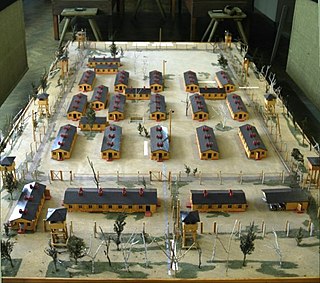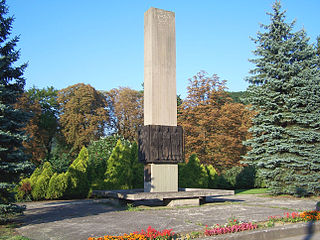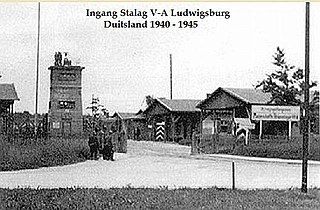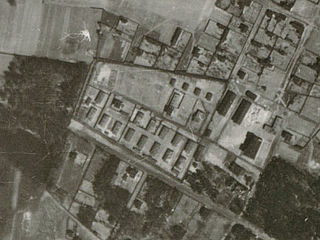Stalag III-C was a German Army World War II prisoner-of-war camp for Allied soldiers. It was located on a plain near the village of Alt Drewitz bei Küstrin then located in the Neumark of the province of Brandenburg, about 50 mi (80 km) east of Berlin.

In Germany, stalag was a term used for prisoner-of-war camps. Stalag is a contraction of "Stammlager", itself short for Kriegsgefangenen-Mannschaftsstammlager, literally "main camp for enlisted prisoners of war". Therefore, "stalag" technically means "main camp".

Radiotelevizija Slovenija – usually abbreviated to RTV Slovenija – is Slovenia's national public broadcasting organization.

Stalag XI-B and Stalag XI-D / 357 were two German World War II prisoner-of-war camps (Stammlager) located just to the east of the town of Fallingbostel in Lower Saxony, in north-western Germany. The camps housed Polish, French, Belgian, Soviet, Italian, British, Yugoslav, American, Canadian, New Zealander and other Allied POWs.

Stalag IX-B was a German World War II prisoner-of-war camp located south-east of the town of Bad Orb in Hesse, Germany on the hill known as Wegscheideküppel. The camp originally was part of a military training area set up before World War I by the Prussian Army.

Stalag IV-B was one of the largest prisoner-of-war camps in Germany during World War II. Stalag is an abbreviation of the German Stammlager. It was located 8 km (5.0 mi) north-east of the town of Mühlberg in the Prussian Province of Saxony, just east of the Elbe river and about 30 mi (48 km) north of Dresden. From 1944 to 1945 it belonged to the Province of Halle-Merseburg. Now, the area is in Brandenburg. A sub-camp, sometimes identified as Stalag IV-B/Z,Stalag 304 or Stalag IV-H was located at Zeithain, 10 km (6.2 mi) to the south in Saxony.

Stalag VIII-C was a German World War II prisoner-of-war camp, near Sagan, Lower Silesia. It was adjacent to the famous Stalag Luft III, and was built at the beginning of World War II, occupying 48 ha. It housed Allied POWs of various nationalities, incl. Polish, French, Belgian, British, Canadian, Greek, Yugoslav, Soviet, Australian, New Zealand, South African, Italian, Senegalese, Algerian, Moroccan and Slovak.

Stalag VIII-D was a German World War II prisoner-of-war camp (Stammlager) located at the outskirts of Teschen,. It was built in March 1941 on the grounds of a former Czech barracks. It was later known as Stalag VIII-B.

Stalag VII-A was the largest prisoner-of-war camp in Nazi Germany during World War II, located just north of the town of Moosburg in southern Bavaria. The camp covered an area of 35 hectares. It served also as a transit camp through which prisoners, including officers, were processed on their way to other camps. At some time during the war, prisoners from every nation fighting against Germany passed through it. At the time of its liberation on 29 April 1945, there were 76,248 prisoners in the main camp and 40,000 or more in Arbeitskommando working in factories, repairing railroads or on farms.

Stalag II-D Stargard was a World War II German Army prisoner-of-war camp located near Stargard, Pomerania. It housed Polish, American, French, Dutch, Belgian, Serbian, Soviet, Italian and Canadian prisoners of war, and Polish civilians.

Stalag V-A was a German World War II prisoner-of-war camp (Stammlager) located on the southern outskirts of Ludwigsburg, Germany. It housed Allied POWs of various nationalities, including Poles, Belgians, Dutchmen, Frenchmen, Britons, Soviets, Italians and Americans.
Stalag XIII-C was a German Army World War II prisoner-of-war camp (Stammlager) built on what had been the training camp at Hammelburg, Lower Franconia, Bavaria, Germany.
The Raid at Ožbalt was the most successful known prison break of the Second World War. It was an operation on 31 August 1944 in which 105 Allied prisoners of war (POWs) were rescued by Slovene Partisans, Special Operations Executive (SOE), and MI9. The majority were liberated from a work site at the village of Ožbalt about 25 kilometres (16 mi) west of Maribor on the railway line to Dravograd in the German Reichsgau Steiermark (Styria), now part of modern-day northern Slovenia. Six of the liberated POWs were separated from the group during an engagement with the Germans a few days after their liberation. One later reunited with the escape group. Following a 14-day trek across 250 kilometres (160 mi) they were flown out of a Partisan airfield at Semič to Bari, Italy. The successful escapees consisted of twenty Frenchmen, nine New Zealanders, twelve Australians, and fifty-nine British POWs.

Stalag XXI-D was a German World War II prisoner-of-war camp based in Poznań in German-occupied Poland, operated in 1940–1945. It held Polish, French, British, Belgian, Dutch, Serbian, Soviet and Italian POWs.

The 2010 Slovenia floods, on the weekend of 17–19 September 2010, were caused by heavy rains in Slovenia, resulting in one of the worst floods in the country's history. Among the regions affected were the capital Ljubljana, the Central Sava Valley, Laško, the Slovene Littoral and Lower Carniola. Initial damage was estimated to reach €15 million. Three people died.
Presidential elections were held in Slovenia on 11 November 2012, with a run-off held on 2 December. Slovenia's 1.7 million registered voters chose between the incumbent president Danilo Türk, the SDS/NSi party candidate Milan Zver and Borut Pahor of the Social Democrats who was also supported by the Civic List. The first round was won, contrary to the opinion poll predictions, by Pahor, with Türk placing second. In the run-off election, Pahor won with roughly two-thirds of the vote.

Parliamentary elections were held in Slovenia on 3 June 2018. The elections were originally expected to be held later in June 2018, but after the resignation of Prime Minister Miro Cerar on 14 March 2018 all parties called for snap elections. They were the third consecutive snap elections after 2011 and 2014.

Stalag Luft II was a Luftwaffe-run prisoner-of-war (POW) camp during World War II, in Łódź, in the occupied territory of Poland.
The following is a timeline of the history of the city of Maribor, Slovenia.

Nazi Germany operated around 1,000 prisoner-of-war camps during World War II (1939-1945).























